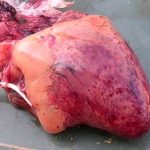Ornithobacteriosis is a highly contagious bacterial disease affecting turkeys, causing respiratory distress, mortality and reduced growth. It was only recently discovered (1993).
The disease agent and its pathogenicity
The etiological agent is Ornithobacterium rhinotracheale (ORT), a bacterium of the Flavobacteriaceae family. It is a pleomorphic bacterium, Gram-negative coccus type, 1-3 µm on 0.2-0.9 µm in size.
This bacterium is identified and detected worldwide. There are currently about a dozen serotypes of varying pathogenicity. The most common serotype encountered is type A. The pathogenicity of the bacterium is highly dependent on environmental factors in animal husbandry, and is often associated with other bacterial infections.
Epidemiological data
The main hosts are turkeys and chickens, but several species are susceptible. Adult animals often have a more severe form of the disease. Disorders are more frequent in turkeys over 14 weeks of age, but cases are reported in younger animals (as early as 11 days). In chickens, the disease affects animals aged 20 to 50 days.
The disease has become a pathological dominant in the turkey sector. It is found all over the world ; in France, cases of ornithobacteriosis are mainly located in Bretagne and Pays de Loire in turkey farms ; most of the time they are linked to another respiratory infection (IB, Newcastle…)
Transmission is mainly by air, and water, but also by vertical transmission, ORT has been isolated in the reproductive tract of infected animals and in their eggs.
Epidemiological investigations reveal the presence of ORT in many farms without an associated systematic clinical form : there is asymptomatic carrying. Wild birds can be considered as potential reservoirs.
Clinical manifestations of the disease
| In turkeys | In laying hens and breeding hens | In broilers |
SymptomsClinical signs are variable, depending on the concomitance of secondary infection and predisposing environmental factors (poor ventilation, overdensity, poor hygiene). ORT is mainly responsible for a respiratory pathology, but can cause growth retardation, locomotor pathologies, mortality and egg-laying falls. |
||
| The disease is severe in adults, with 15-50% mortality, but youngs are less affected. Turkeys are in respiratory distress (cough), sneeze ; nasal exudate and swollen sinuses are observed. Egg laying is reduced and eggs are of poor quality. | The disease is often expressed at the peak of egg laying, or just before egg laying. There is an increase in mortality, a decrease in consumption and slight respiratory signs. There may be a drop in egg laying, deformed and smaller eggs. Paralysis is sometimes observed. ORT has been isolated in cases of tenosynovitis, in non-moving subjects with decreased growth and swollen joints. | Chickens are lethargic, drink and eat less, experience a drop in ADG ; nasal exudate and sneezing, head edema, with or without respiratory signs, and sometimes sudden death are observed. Paralysis is also sometimes observed. Mortality is 2 to 10%. |
LesionsLesions of the respiratory system are observed : sinusitis, mucosal tracheitis, pneumonia, often unilateral with hepatitis, aerosacculitis with mucous exudate. |
||
| Splenomegaly, arthritis and osteomyelitis can occur. In tenosynovitis, there is uni- or bilateral swelling of the tarsometatarsal joint, with serous and then seropurulent discharge upon excision ; there is also edema of the tendon sheaths around the joint, as well as adjacent muscle and subcutaneous tissues. | Subcutaneous head edema, osteomyelitis and encephalitis occur. | |
The diagnosis
Clinical signs and lesions have little diagnostic value. The diagnosis of certainty is established thanks to the laboratory diagnosis :
- Direct diagnosis : The diagnosis involves bacteriology with culture on blood agar in a micro-aerophilic atmosphere, from samples of trachea, lung and air sacs. It should be noted that Ornithobacterium rhinotracheale is suspected, as the colonies are small and can easily be masked by other bacteria (Proteus, Coli). In addition, it is a late diagnosis, with a delay of 2-3 days for bacteriological results, followed by 24 hours for the antibiotic susceptibility test. PCR detection can be implemented and immunohistochemical techniques are described.
- Indirect diagnosis : Serology is possible using the agglutination test or the ELISA test. However, the seropositivity of a batch is frequent and does not allow diagnosis, serological follow-up must be carried out to detect seroconversion.
Differential diagnosis
Infectious turkey rhinotracheitis, E. coli, Pasteurella, Riemerella, Haemophilus, Chlamydophila, BI, big head syndrome. All causes of tenosynovitis.
Disease prevention and control
As this it is a highly contagious disease, a strict cleaning and disinfection protocol is required. Similarly, single-band is preferable.
Medical check-up
The sensitivity of ORT to antibiotics is variable. Most strains isolated in France are sensitive to amoxicillin, spectinomycin and ceftiofur, and are often resistant to colistin. In all cases, an antibiotic susceptibility test is required. Treatment must be maintained for at least 4 days.
Vaccination
Live or attenuated vaccines reduce mortality and disease expression in poultry. Oily adjuvanted autovaccines have been shown to be effective on turkeys.







